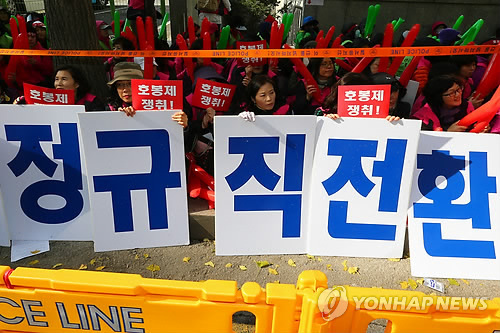The number of nonregular workers surpassed 6 million this year for the first time since the government began collecting related data in 2002 amid public debate over their pay and conditions.
According to Statistics Korea, the number of contract employees came to 6.07 million as of August 2014, up 130,000 from a year earlier.
This year also saw an increase of more than 5 percent, or 320,000 individuals, compared with five years ago, when the number stood at 5.75 million.
The steady growth of the total number of nonregular workers came in spite of the government’s efforts to turn such temporary jobs into regular ones through incentives and state-led programs.
While the ratio of nonregular jobs to the total number of salaried employees has remained around 33 percent, the income gap between regular and nonregular workers has widened, market insiders said.
According to Statistics Korea, the number of contract employees came to 6.07 million as of August 2014, up 130,000 from a year earlier.
This year also saw an increase of more than 5 percent, or 320,000 individuals, compared with five years ago, when the number stood at 5.75 million.
The steady growth of the total number of nonregular workers came in spite of the government’s efforts to turn such temporary jobs into regular ones through incentives and state-led programs.
While the ratio of nonregular jobs to the total number of salaried employees has remained around 33 percent, the income gap between regular and nonregular workers has widened, market insiders said.

The monthly income disparity was 990,000 won ($925) in 2009 but it steadily rose to 1.15 million won in 2014.
Wage hikes were made in favor of regular workers. Though the average wage for regular employees rose 2.3 percent on-year in 2014, the wage for contract workers inched up 1.8 percent, the data showed.
The average monthly wage for contract workers increased just 25,000 won from a year before to stay at 1.45 million won, about 55 percent of the level of regular workers.
The level is quite low compared to other members of the Organization for Economic Cooperation and Development.
According to the OECD, wages for nonregular workers in major countries now amount to 70 percent of those of regular workers on average.
Germany saw the percentage of salaries for nonregular workers to salaries for regular workers reach 83 percent. The ratios were 79 percent for Belgium, 78 percent for Demark, 77 percent for Finland and 74 percent for the United Kingdom.
The salary gap for nonregular jobs in southern Europe was also higher than that of South Korea. Greece saw a ratio of 67 percent and Portugal 65 percent.
A report from the LG Economic Research Institute said the poor treatment of nonregular workers was “attributable to the situation that more businesses have pushed forth the increase of nonregular jobs as the high cost of regular workers are burdening them amid the protracted economic slowdown.”
Labor-related experts shared the view that South Korea should benchmark the cases of advanced countries, where businesses often pay employees according to flexible working hours.
Though the Park Geun-hye administration is also trying to expand the number of part-time positions, opposition parties say that this will only lead to more low-quality jobs.
The data showed that women outnumbered men with female contract workers counting for 53.5 percent, or 3.25 million individuals, as of August in 2014.
By age, contract workers in their 40s topped the list with 21.3 percent, followed by 21.1 percent for those in their 50s. Those in their 30s had the lowest rate of nonregular employment, at 17.2 percent.
By Kim Yon-se (kys@heraldcorp.com)


![[AtoZ into Korean mind] Humor in Korea: Navigating the line between what's funny and not](http://res.heraldm.com/phpwas/restmb_idxmake.php?idx=644&simg=/content/image/2024/04/22/20240422050642_0.jpg&u=)
![[Exclusive] Korean military set to ban iPhones over 'security' concerns](http://res.heraldm.com/phpwas/restmb_idxmake.php?idx=644&simg=/content/image/2024/04/23/20240423050599_0.jpg&u=20240423183955)



![[Graphic News] 77% of young Koreans still financially dependent](http://res.heraldm.com/phpwas/restmb_idxmake.php?idx=644&simg=/content/image/2024/04/22/20240422050762_0.gif&u=)
![[Herald Interview] Why Toss invited hackers to penetrate its system](http://res.heraldm.com/phpwas/restmb_idxmake.php?idx=644&simg=/content/image/2024/04/22/20240422050569_0.jpg&u=20240422150649)





![[Exclusive] Korean military to ban iPhones over security issues](http://res.heraldm.com/phpwas/restmb_idxmake.php?idx=652&simg=/content/image/2024/04/23/20240423050599_0.jpg&u=20240423183955)



![[Today’s K-pop] Ateez confirms US tour details](http://res.heraldm.com/phpwas/restmb_idxmake.php?idx=642&simg=/content/image/2024/04/23/20240423050700_0.jpg&u=)